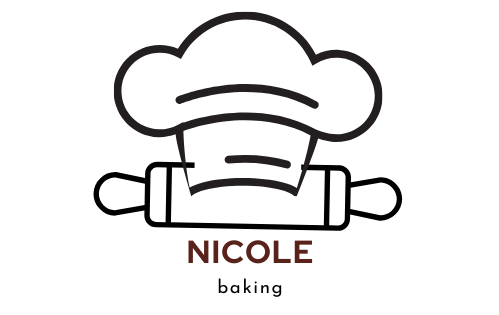
We’ve discovered that a good non-stick ceramic pan can revolutionize cooking. With the rise of healthier cooking options, it’s no surprise that over 60% of home cooks are switching to ceramic cookware for its safety and efficiency.
Our favorite choice is the Caraway pan, renowned for its super smooth and scratch-resistant surface, making effortless cooking a reality. This top-rated ceramic frying pan ensures that food doesn’t stick, and cleanup is a breeze.
By choosing the right cookware, we can make a significant difference in our cooking experience. The benefits of a non-stick surface, combined with the safety of ceramic material, make for a compelling case for upgrading your kitchen staples.
What is a Ceramic Frying Pan?
The world of cookware is vast, but ceramic frying pans stand out due to their non-stick properties and safety features. As we explore the realm of ceramic cookware, it’s essential to understand what makes it unique and beneficial for cooking.
Overview of Ceramic Cookware
Ceramic cookware is derived from silica, a component found in natural materials like sand and granite. This composition gives ceramic frying pans their durability and non-toxic characteristics, making them a popular choice among home cooks and professional chefs alike.
Benefits of Using Ceramic
The benefits of using ceramic cookware are numerous. Firstly, it offers excellent non-stick properties, making food release easy and cleaning a breeze. Additionally, ceramic frying pans are free from harmful chemicals often found in traditional non-stick coatings, ensuring a safer cooking experience.
| Feature | Description | Benefit |
|---|---|---|
| Non-Stick Surface | Made from ceramic materials | Easy food release and cleaning |
| Durability | Resistant to scratches and chips | Long-lasting cookware |
| Safety | Free from toxic chemicals | Healthier cooking option |
While ceramic frying pans offer many advantages, it’s worth noting that the ceramic coating can degrade over time. However, this degradation does not pose the risk of off-gassing associated with some other non-stick materials, making ceramic a safer choice in the long run.
The Advantages of Cooking with Ceramic
The advantages of using ceramic frying pans are numerous, ranging from their non-stick properties to their health benefits. We find that cooking with ceramic not only enhances the flavor of our dishes but also makes the cooking process more efficient and healthier.
Non-Stick Properties
Ceramic frying pans are renowned for their exceptional non-stick surface. This feature is particularly beneficial when cooking delicate foods such as eggs, pancakes, or crepes, as they can be flipped and removed with ease. The non-stick property is due to the ceramic coating, which is PTFE-free and PFOA-free, ensuring a safer cooking experience.
- Easy food release
- Simplified cleaning process
- Reduced need for excessive oil or butter
Health Benefits
Cooking with ceramic frying pans offers several health benefits. The absence of PTFE and PFOA in ceramic coatings means that our food does not come into contact with these potentially harmful chemicals. Moreover, the non-stick surface allows for cooking with less oil, contributing to a healthier diet. We appreciate that ceramic pans are a great option for those looking to reduce their fat intake without compromising on flavor.
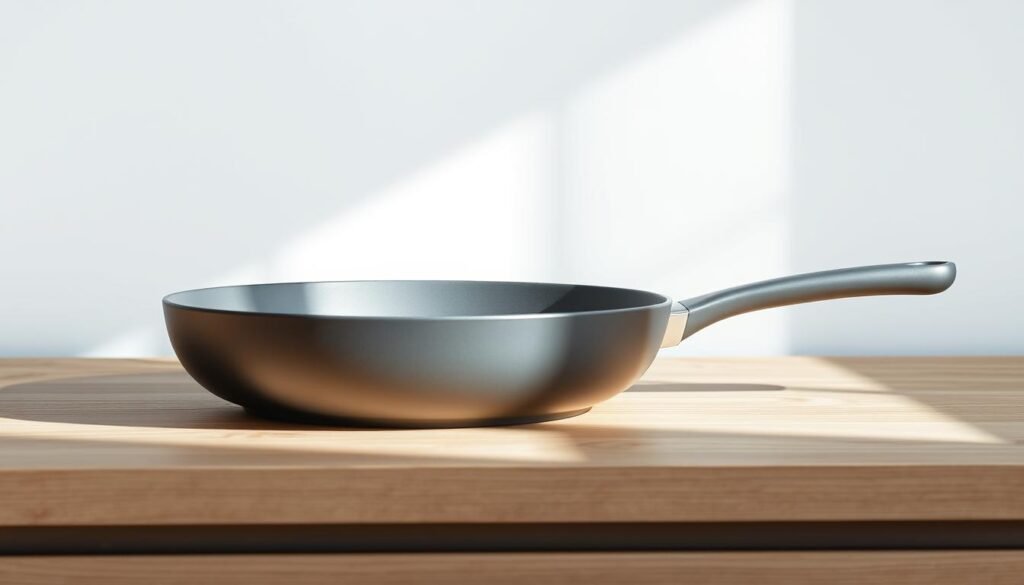
Even Heat Distribution
Another significant advantage of ceramic frying pans is their ability to distribute heat evenly. This characteristic ensures that our dishes are cooked consistently, reducing the risk of hotspots that can lead to burnt or undercooked areas. The even heat distribution is a result of the ceramic material’s thermal conductivity, making it an ideal choice for a variety of cooking techniques, from searing to simmering.
- Consistent cooking results
- Enhanced flavor due to uniform heating
- Versatility in cooking methods
In conclusion, the advantages of cooking with ceramic frying pans make them a valuable addition to any kitchen. With their non-stick properties, health benefits, and even heat distribution, ceramic pans offer a superior cooking experience that is both healthy and enjoyable.
Our Top Picks for Ceramic Frying Pans
Our selection of the best ceramic frying pans is based on rigorous testing and a keen eye for quality and value. We’ve scoured the market to find pans that not only promise a great cooking experience but also stand the test of time.
Best Overall: GreenPan
The GreenPan Valencia Pro stands out for its exceptional non-stick surface and durability. With its ability to withstand oven temperatures up to 600°F, it’s perfect for a variety of cooking techniques. The GreenPan is a versatile choice for any kitchen, offering a healthy cooking alternative without compromising on performance.
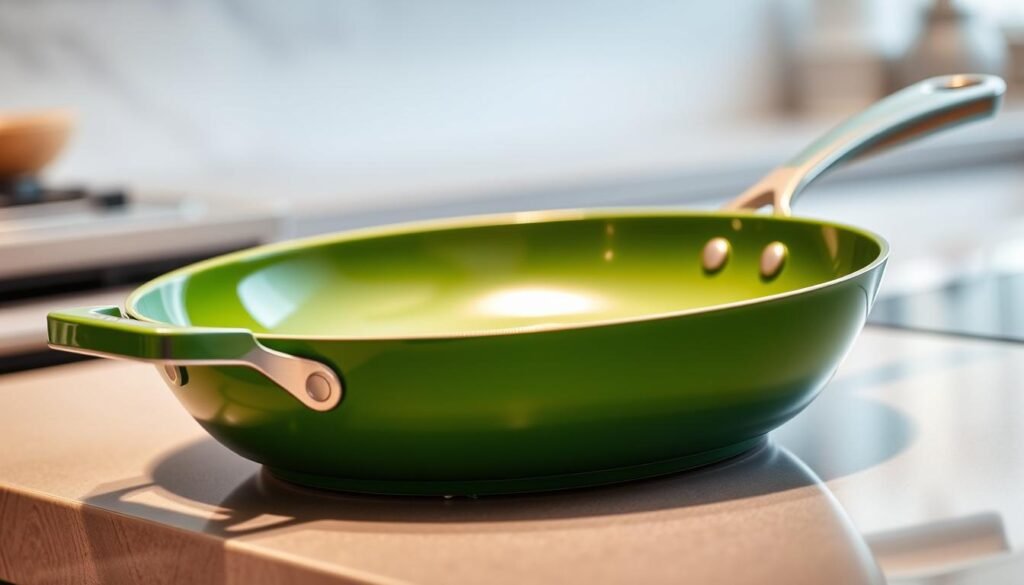
Budget-Friendly Option: T-fal
For those on a budget, T-fal offers excellent value with its granite ceramic 10.5-inch fry pan. This pan is not only affordable but also provides a reliable non-stick surface and easy cleaning. T-fal’s commitment to quality at an accessible price makes it a favorite among home cooks.
- Affordable without compromising on quality
- Effective non-stick surface
- Easy to clean and maintain
Premium Choice: Scanpan
Scanpan is renowned for its premium quality and innovative design. The Scanpan ceramic frying pan set is a testament to the brand’s commitment to excellence, offering a product that is both functional and stylish. With its durable construction and superior heat distribution, Scanpan is a top choice for those seeking a high-end cooking experience.
- Durable and long-lasting
- Excellent heat distribution
- Aesthetic design that complements any kitchen
In conclusion, whether you’re looking for the best overall value, a budget-friendly option, or a premium product, our top picks for ceramic frying pans cater to a wide range of preferences and needs. Each of these brands – GreenPan, T-fal, and Scanpan – offers a unique set of benefits that make them stand out in the market.
How to Choose the Right Ceramic Frying Pan
The key to effortless cooking lies in selecting the right ceramic frying pan, and we’re here to help you make that decision. When it comes to choosing the perfect pan, several factors come into play.
Size Considerations
One of the first things to consider is the size of the pan. Ceramic frying pans come in various sizes, typically ranging from 8 to 14 inches in diameter. The size you choose should depend on your cooking needs and the number of people you’re cooking for. For instance, a smaller pan (8-10 inches) is ideal for solo cooking or cooking for two, while larger pans (12-14 inches) are better suited for families or when you’re cooking in bulk.
Choosing the right size can also impact your cooking technique. A larger pan provides a bigger surface area, which can be beneficial for certain dishes like stir-fries or searing meat. On the other hand, a smaller pan allows for more precise control over your cooking, which is great for delicate foods like eggs or crepes.
| Pan Size (inches) | Ideal For | Cooking Techniques |
|---|---|---|
| 8-10 | Solo cooking, couples | Delicate foods, precise control |
| 12-14 | Families, bulk cooking | Stir-fries, searing meat |
Handle Material and Design
The handle of your ceramic frying pan is another crucial aspect to consider. A well-designed handle can make a significant difference in your cooking experience, providing comfort and safety. Look for handles made from materials that stay cool during cooking, such as stainless steel or silicone-coated handles. The design should also allow for a secure grip, making it easier to maneuver the pan, especially when it’s filled with food.
A comfortable handle can reduce fatigue and make cooking more enjoyable. Some pans also come with a helper handle on the opposite side, which can be very useful for larger pans, making them easier to lift and pour.
Compatibility with Heat Sources
Not all ceramic frying pans are compatible with every heat source. Before making a purchase, ensure that the pan you choose can be used on your cooktop. Whether you have a gas stove, electric stove, or induction cooktop, compatibility is key. Some ceramic pans are also oven-safe, which can be a valuable feature for certain recipes.
Checking compatibility is crucial to avoid damaging your pan or cooktop. For induction cooking, look for pans with a ferromagnetic bottom. For oven use, check the manufacturer’s guidelines for temperature limits.
- Check the manufacturer’s guidelines for heat source compatibility.
- Consider a pan that is versatile and can be used across different cooking surfaces.
- Look for a ceramic skillet with a lid for added versatility in your cooking.
Caring for Your Ceramic Frying Pan
To get the most out of your ceramic frying pan, proper care is essential. A well-maintained pan not only lasts longer but also continues to perform at its best, ensuring your cooking experiences are always delightful.
Proper Cleaning Techniques
Gentle hand washing is the recommended method for cleaning ceramic frying pans. Avoid using abrasive cleaners or scouring pads, as these can damage the ceramic coating. Instead, use mild soap and a soft sponge to clean your pan.
- Wash the pan in warm soapy water.
- Use a soft sponge or cloth to clean the pan.
- Rinse thoroughly and dry with a towel.
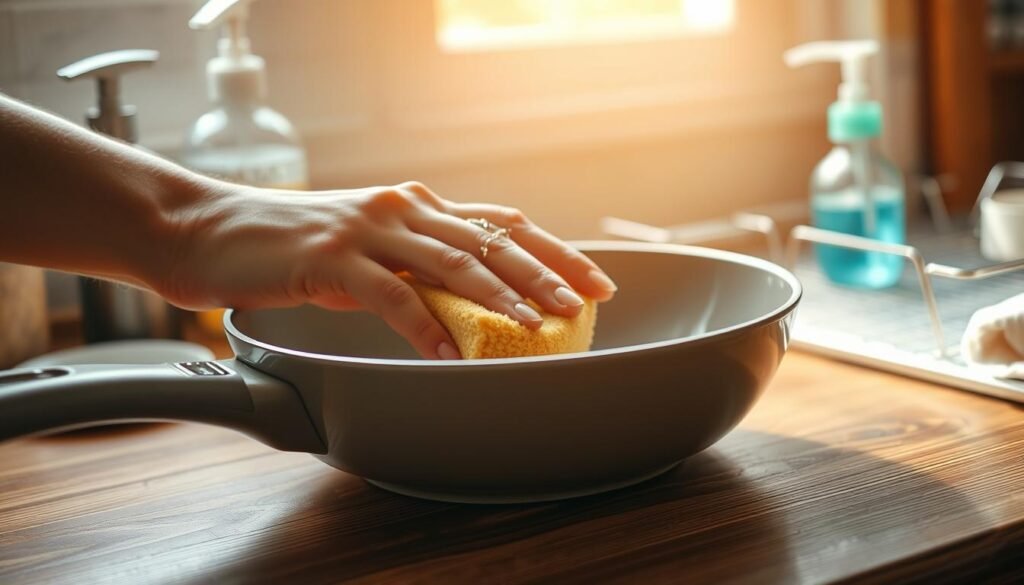
Avoiding Scratches and Damage
To maintain your ceramic frying pan’s non-stick surface, it’s crucial to avoid scratches. Using metal utensils can scratch the pan, so opt for silicone, wooden, or plastic utensils instead. Additionally, avoid stacking your ceramic pans on top of each other, as this can cause chipping or scratching.
- Use non-metal utensils to prevent scratching.
- Avoid stacking ceramic pans.
- Store pans separately or use pan protectors.
Recommendations for Maintenance
Regular maintenance is key to extending the life of your ceramic frying pan. Regularly check your pan for signs of wear, and address any issues promptly. For example, if you notice the non-stick coating is deteriorating, consider re-seasoning the pan if recommended by the manufacturer.
- Regularly inspect your pan for damage.
- Follow the manufacturer’s maintenance instructions.
- Re-season the pan if necessary and recommended.
By following these simple care and maintenance tips, you can enjoy cooking with your ceramic frying pan for a long time. Proper care not only enhances the pan’s durability but also ensures it continues to cook your meals to perfection.
Cooking Techniques with Ceramic Frying Pans
The ceramic frying pan is a kitchen staple that can handle everything from delicate sautéing to high-heat searing. Its non-stick surface and even heat distribution make it an ideal tool for a variety of cooking techniques.
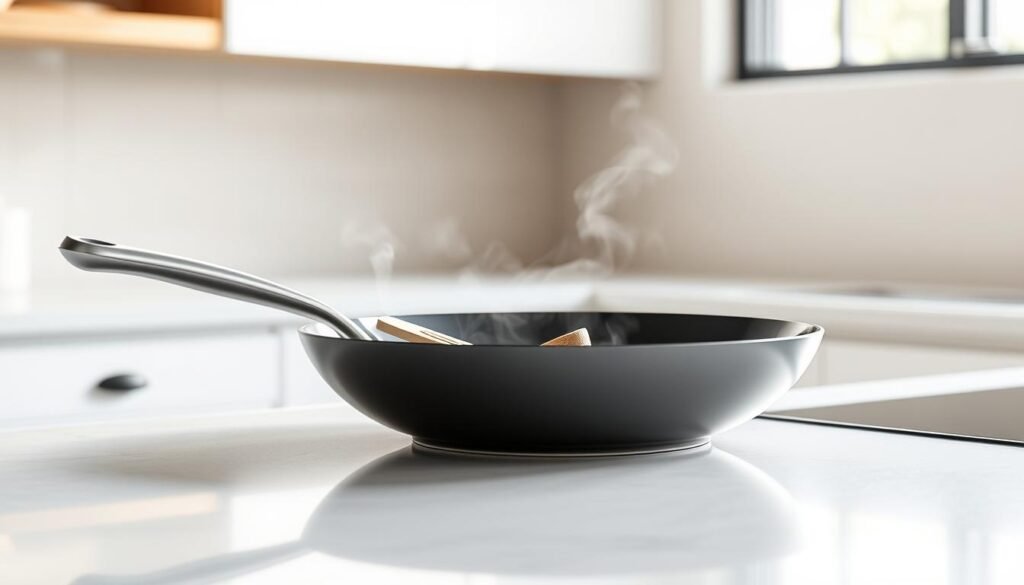
Searing and Browning
Searing meat to perfection is a breeze with a ceramic frying pan. The pan’s ability to distribute heat evenly ensures a consistent sear across the meat’s surface. To achieve the best results, preheat the pan over medium-high heat, add a small amount of oil, and then add your meat. Let it cook undisturbed for a few minutes to get a nice crust.
Stir-Frying
Stir-frying is another technique that ceramic frying pans excel at. The non-stick surface prevents vegetables and meat from sticking and makes stirring easy. To stir-fry effectively, heat the pan over high heat, add your ingredients, and constantly stir to ensure everything cooks evenly.
Sautéing Vegetables
Sautéing vegetables is a quick and healthy way to prepare a meal, and ceramic frying pans are perfect for this task. The pan’s heat distribution cooks the vegetables evenly, and the non-stick surface prevents them from sticking. Simply heat the pan over medium heat, add a bit of oil, and then add your vegetables, stirring occasionally until they’re tender.
| Cooking Technique | Heat Level | Tips |
|---|---|---|
| Searing | Medium-High | Use a small amount of oil, don’t disturb the meat. |
| Stir-Frying | High | Constantly stir ingredients, use high heat. |
| Sautéing | Medium | Add a bit of oil, stir occasionally until vegetables are tender. |
By mastering these cooking techniques with your ceramic frying pan, you’ll be able to prepare a wide range of delicious meals with ease. Whether you’re cooking for one or for a crowd, the ceramic frying pan is a versatile and reliable tool that will become a staple in your kitchen.
Comparing Ceramic Frying Pans with Other Materials
Ceramic frying pans have gained popularity, but how do they stack up against other materials like stainless steel and cast iron? In this section, we’ll delve into the comparisons between ceramic frying pans and other common cookware materials, examining their durability, health safety, ease of cleaning, and cooking performance.
Ceramic vs. Stainless Steel
Stainless steel frying pans are known for their durability and resistance to corrosion. However, they can be challenging to cook with at high heats, and food often sticks to the surface. In contrast, ceramic pans offer a non-stick surface that’s healthier and easier to clean. While stainless steel pans are more durable, ceramic pans provide a more versatile cooking experience.
Key differences:
- Ceramic pans are non-stick, while stainless steel pans require seasoning or oil to prevent sticking.
- Ceramic pans are generally easier to clean than stainless steel pans.
- Stainless steel pans are more durable and resistant to scratches.
Ceramic vs. Cast Iron
Cast iron pans are renowned for their heat retention and versatility in cooking techniques, from searing to baking. However, they require regular seasoning to prevent rust and can be heavy and difficult to handle. Ceramic pans, on the other hand, are lightweight and easy to maneuver, making them ideal for everyday cooking. While cast iron pans can last for decades with proper care, ceramic pans offer a more convenient and low-maintenance alternative.
Key differences:
- Cast iron pans retain heat exceptionally well, while ceramic pans heat up quickly but may not retain heat as long.
- Ceramic pans are easier to clean and maintain than cast iron pans.
- Cast iron pans are more versatile in terms of cooking techniques.
Ceramic vs. Non-Stick Coated
Traditional non-stick coated pans are coated with chemicals like PFOA, which can be harmful when heated to high temperatures. Ceramic pans, by contrast, are made with a non-toxic, PFOA-free coating, making them a healthier choice. While both types offer non-stick properties, ceramic pans are generally more durable and less prone to chipping.
Key differences:
- Ceramic pans are PFOA-free, making them a healthier option.
- Ceramic pans are more durable and less likely to chip than traditional non-stick pans.
- Both ceramic and non-stick pans offer easy food release, but ceramic pans are more resistant to scratches.
In conclusion, ceramic frying pans offer a unique blend of health safety, ease of use, and cooking performance that makes them an attractive option for home cooks. By understanding how they compare to other materials, you can make an informed decision that suits your cooking needs.
Common Myths About Ceramic Frying Pans
There’s a lot of misinformation about ceramic frying pans that we aim to clarify. While they have gained popularity for their non-stick properties and health benefits, there are still several misconceptions surrounding their use and durability.
Durability Concerns
One of the most common myths about ceramic frying pans is that they are not durable. While it’s true that they can be more delicate than other materials, proper care can significantly extend their lifespan. For instance, avoiding the use of metal utensils and not stacking them on top of each other can prevent chipping and scratching.
Tips for Enhancing Durability:
- Use silicone or wooden utensils to prevent scratching.
- Avoid extreme temperature changes.
- Clean the pan gently after each use.
| Care Tip | Benefit |
|---|---|
| Using silicone utensils | Prevents scratching and chipping |
| Avoiding extreme temperature changes | Reduces risk of damage |
| Gentle cleaning | Maintains non-stick surface |
Heat Resistance Misunderstandings
Another misconception is that ceramic frying pans cannot handle high heat. In reality, most ceramic pans are designed to be heat-resistant, but sudden changes in temperature can cause damage. It’s essential to preheat the pan gradually and avoid placing a hot pan under cold water.
Understanding Heat Resistance:
- Ceramic pans can handle medium to high heat.
- Preheating should be done gradually.
- Avoid sudden temperature changes.
By understanding the facts behind these common myths, users can better appreciate the benefits and limitations of ceramic frying pans. With proper care and use, these pans can be a valuable addition to any kitchen.
Safety Tips for Using Ceramic Frying Pans
When it comes to cooking with ceramic frying pans, safety should always be our top priority. Ensuring that we use these pans correctly not only prolongs their lifespan but also prevents potential hazards in the kitchen.
Recommended Cooking Temperatures
Ceramic frying pans are known for their heat distribution properties, but it’s crucial to use them within the recommended temperature range. Most ceramic pans are safe up to 450°F (232°C), but it’s always best to check the manufacturer’s guidelines.
Using your ceramic frying pan at the right temperature ensures that your food is cooked evenly and prevents damage to the pan. Avoid extreme temperature changes, as this can cause the ceramic to crack or degrade over time.
| Cooking Method | Recommended Temperature | Notes |
|---|---|---|
| Searing | Medium-High (400°F/204°C) | Use a thermometer to ensure the right temperature. |
| Stir-Frying | Medium (350°F/177°C) | Keep ingredients moving to prevent burning. |
| Simmering | Low (300°F/149°C) | Ideal for sauces and soups. |
Safe Use for Families
When cooking for families, especially with children around, it’s vital to take extra precautions. Ensure that the handle of your ceramic frying pan is cool to the touch or use oven mitts to handle the pan when it’s hot.
- Keep children away from the cooking area.
- Use a pan with a stay-cool handle.
- Never leave a hot pan unattended.
By following these safety tips, you can enjoy cooking with your ceramic frying pan while maintaining a safe kitchen environment for everyone.
Recipes Perfect for Ceramic Frying Pans
With a ceramic frying pan, the possibilities for delicious meals are endless. Ceramic pans are ideal for a variety of dishes, from omelets and pancakes for breakfast to sautéed vegetables and grilled meats for dinner. The non-stick surface and even heat distribution of ceramic pans make cooking and cleaning a breeze.
Quick Breakfast Ideas
Start your day off right with these quick and easy breakfast recipes using your ceramic frying pan.
- Fluffy Pancakes: Mix together 1 cup of pancake batter, 1 egg, and 1/2 cup of milk. Cook on a preheated ceramic pan over medium heat until bubbles appear on the surface. Flip and cook until golden brown.
- Scrambled Eggs with Vegetables: Scramble 2 eggs with salt and pepper to taste. Add diced vegetables like bell peppers, onions, and mushrooms. Cook in a ceramic pan until the vegetables are tender.
- Avocado Toast with Poached Eggs: Toast some whole grain bread, mash an avocado, and spread it on top. Poach an egg in a ceramic pan with simmering water and place it on top of the avocado toast.
Healthy Dinner Options
Ceramic frying pans are not just limited to breakfast; they’re perfect for healthy dinner options too.
- Grilled Salmon with Lemon: Season a salmon fillet with salt, pepper, and lemon juice. Grill in a ceramic pan over medium-high heat until cooked through. Serve with a side of roasted vegetables.
- Sautéed Spinach with Garlic Shrimp: Cook garlic shrimp in a ceramic pan until pink. Add a handful of spinach and cook until wilted. Serve with quinoa or brown rice.
- Stir-Fried Vegetables with Tofu: Stir-fry a variety of colorful vegetables like broccoli, carrots, and bell peppers with cubed tofu in a ceramic pan. Season with soy sauce and serve over rice.
These recipes showcase the versatility of ceramic frying pans and inspire you to create delicious meals. Whether you’re cooking for one or for a family, ceramic pans are a great addition to your kitchen arsenal.
Our Final Thoughts on Ceramic Frying Pans
As we reflect on the benefits and versatility of ceramic frying pans, it’s clear why they’ve become a staple in many kitchens. We love ceramic pans for their non-stick properties, health benefits, and even heat distribution, making cooking effortless and enjoyable.
The Benefits That Resonate
Ceramic frying pans offer a healthier cooking alternative, free from the chemicals found in traditional non-stick coatings. Their durability and ease of cleaning make them a practical choice for daily cooking.
Embracing Change in the Kitchen
Incorporating ceramic frying pans into our kitchen arsenal can be a game-changer. With their versatility in cooking techniques, from searing to sautéing, they open up new possibilities for culinary exploration. As we share our final thoughts, we’re excited about the kitchen change that ceramic pans can bring, enhancing our cooking experience and encouraging healthier eating habits.
